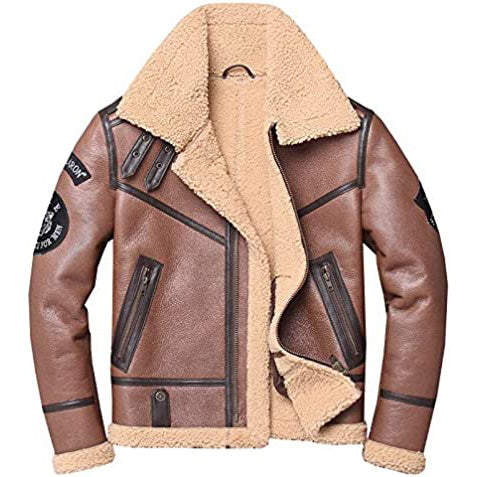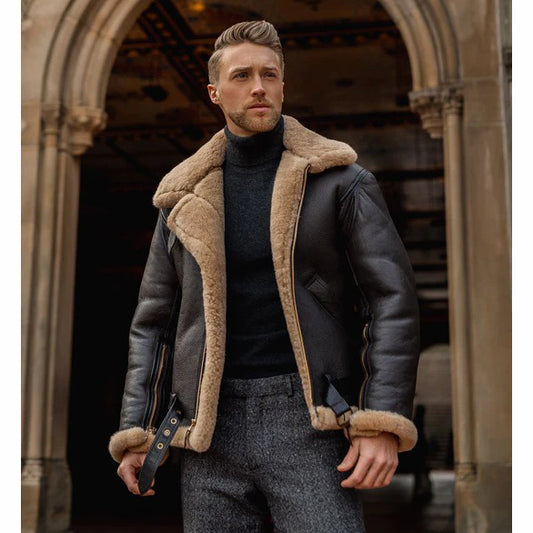Introduction: why authenticity matters for Avirex fans
Avirex stands for heritage, heavy leather, and bold street culture. That is why counterfeits flood the market. When a copy cuts corners on leather, lining, hardware, and build, it fails fast and looks wrong under daylight. This guide shows how to verify an authentic avirex jacket using simple checks anyone can perform at home or at a store. Expect a clear checklist, a side by side table, and expert insight that will help you buy with confidence.
Looking for a safe source while you learn. Explore the selection of Original Avirex leather jackets at Jackets Kingdom, a curated hub that favors quality and clear return policies. The goal is to protect your money and time while you track down the right piece. If a listing feels off, it likely is. Keep reading to confirm the details that matter.
Key Takeaways
- Real Avirex uses thick full grain leather, precise stitching, clean chenille or embroidery, and branded or premium hardware like YKK zipper parts.
- Labels and care tags should be crisp, with correct fonts, spacing, and a sensible model or style code and a serial number or SKU.
- Cheap price, stock photos, and limited returns are major red flags.
- Compare the jacket in hand to official product photos and proven sales from reputable sellers.
- If in doubt, get a second opinion from a leather specialist or a trusted authentication service.
Price and seller signals that predict authenticity
Before touching the jacket, audit the listing and the seller. Counterfeits bait buyers with prices that are far below market. Study sold listings on major resale platforms to set expectations for the model and size. A pristine bomber from a recent line should not sit at a deep discount with vague photos. Read the description for clarity about leather type, lining, year, origin, and condition. Scammers keep it vague or paste generic text. Inspect the return policy. Authentic sellers stand behind their items with a fair window and clear terms. Check seller history, feedback, and whether they have sold avirex leather jackets before. Ask for daylight photos from several angles, including labels, hardware, linings, and hems. If a seller refuses to provide new photos or dodges questions, walk away. A little due diligence upfront prevents the most common mistakes when comparing real vs fake avirex listings.
Leather first: grain, temper, smell, and wear
Leather is the soul of an authentic avirex jacket. Real pieces use heavy full grain cowhide or goatskin with a rich grain and weight. Run fingers across the surface. Real leather feels warm and has subtle variation, not a flat plastic sheen. Flex the sleeve. Quality hides develop soft creases and recover without cracking. The smell test helps too. Real hides have a distinct, earthy scent, while PU leather smells chemical. Examine edges where wear shows first like cuffs and hem. Natural leather builds patina, not flakes. Ask for close ups of the grain in daylight, especially on the back panel and sleeves. If possible, weigh the jacket. Heavy leather jackets often feel substantial in hand. Do not perform destructive tests. No burn tests or solvent rubs. If the listing mentions fake spellings like averix, treat that as a warning sign that something is off even before you inspect the rest.
Compare against official photos and trusted product pages
Bring a known reference to the table when you evaluate the jacket. Cross check the model, patch layout, embroidery scale, and color with current or archived brand photos. Pay special attention to the size and kerning of letter patches on the back and the exact shape of logos. Small differences often expose counterfeits. When shopping new season drops, confirm the colorways offered by official channels. If the seller claims a rare color that never released, that is a red flag. For a smooth and secure purchase journey, browse an Avirex jackets online store that posts original photos, close ups of labels, and full measurements. Save screenshots and compare them with any listing you are considering. In the end, direct comparison with verified imagery reveals many fakes without guesswork.
Labels, brand marks, and care tags to examine closely
Open the jacket and study every label. Fonts must be sharp and consistent. Spacing should be even, and the stitching around the label neat. Older pieces may show Made in USA or Italy depending on the era and line, but the print should still be crisp and not washed out. Look for a care label with material content, washing instructions, and a model or style code. Many real jackets include a production code or batch tag. If there is a serial number, it should follow a consistent format and be placed in a sensible location, often near the care label or inner seam. Beware of typos, misaligned borders, and labels that look glossy or bubbled. Counterfeiters often get the paper stock wrong and the edges fray or lift too easily. Compare the interior brand mark to known genuine example photos and confirm the presence or absence of a registered mark symbol from that production period.
Stitching density, seam alignment, and panel layout
Construction quality is a strong tell for authenticity. Study seam lines at the shoulders, sides, and hem. Stitching should be straight and evenly spaced with no loose threads. Corners where panels meet should not pucker. Examine the rib knit cuffs and waistband. They should be firm, not flimsy, with clean joins to the leather. Check the collar seam for symmetry and even topstitching that follows the curve. Inside the jacket, turn out the lining and locate stress points like the armholes. A genuine build uses reinforcement stitching where needed. Counterfeits skip reinforcements and show uneven thread tension that leads to ripples. Use daylight or a bright lamp and take macro photos if buying remotely. When you compare real vs fake avirex side by side, stitching flaws stand out at once and show why a knockoff will not last under regular wear.
Patches, chenille, and embroidery quality
The bold back letters and chest emblems are iconic. Their quality should be high. On genuine pieces, the chenille patch has dense fibers and clean borders. The fill is plush, and the edge stitching is tight with no stray ends. Embroidery has consistent thread sheen and tight tension. Letters align without warping. Look closely at curves and inner corners where fakes often wobble. The scale of the back AVIREX or AVIREX USA lettering should match known references. Measure letter height and spacing if needed. Printed graphics should be sharp with solid color fills, not streaky. Heat pressed elements should sit flat without bubbles or silvering. Avoid pieces where glue bleeds at the patch edge. Some special releases mix embroidery and applique. If a listing shows a method the brand did not use for that model, take it as a sign of a counterfeit.
Hardware check: zippers, pulls, snaps, and sliders
Hardware separates a premium jacket from a poor copy. Inspect zipper teeth and pulls. Many genuine jackets use high grade components like a YKK zipper or custom branded pulls. The pull tab should feel solid, not tinny, and the slider should glide without snags. Teeth should align and lock cleanly at the bottom. Snaps and buttons should seat with a firm click and often show neat branding or a smooth matte finish. Loose snaps or wobbly shanks are common on fakes. Check the color of metal parts across the jacket. Consistency matters. Mixed tones signal swapped or cheap parts. Look at the zipper tape stitching. It should be straight with a tidy back tack at the ends. Compare pulls and snaps to official product photos for that model. Hardware that does not match the release is a frequent giveaway that the jacket is not genuine.
Lining, pocket bags, and inside finishing
Turn the jacket inside out. The lining should be robust and well attached around seams and vents. Many avirex leather jackets feature smooth satin or durable twill linings. Prints should be crisp if present, not blurry. Pocket bags should use sturdy cotton or twill, not thin polyester that tears with a tug. Check the interface where lining meets the zipper tape and the hem. The stitching should be even and sit flat. At the underarm, look for neat bar tacks or reinforcement stitches. Labels inside the pocket or behind the inner chest region can carry helpful production codes. Excess glue residue, loose threads, or raw edges signal poor finishing. Pay attention to how the lining hangs. It should not bubble or twist. When the inside looks refined, the outside quality usually follows, and that supports a confident call on authenticity.
Fit, pattern, and proportion as a tell
Authentic patterns look balanced and wear well. Shoulders should sit square and true to size, sleeves follow a gentle taper, and the body length should match the model type such as bomber or varsity. Fakes often miss the proportion. Sleeves run too long or the armholes feel tight, while the chest is boxy. Ask for flat measurements and compare with known charts from brand listings. Key measures include shoulder width, chest pit to pit, back length, and sleeve length from shoulder seam. The collar shape should hold clean lines. Check rib knit proportions. Oversized waistbands or floppy cuffs are warning signs. Try the jacket on if possible and raise your arms. A solid pattern allows movement without pulling the back seam. Poor pattern balance reveals itself in posture and comfort and often points to a counterfeit build.
Weight, drape, and touch tests that do not damage
Non destructive tests tell a lot. Lift the jacket by the hanger loop and feel the weight. Heavy leather has a presence, while light jackets with bulky looks often mean poor materials. Drape the sleeve over your hand. Quality leather falls with a natural curve and does not feel stiff like cardboard. Press the leather with a thumb at an inconspicuous area and release. Real leather shows a soft bloom and returns without a crease. Tap the hardware. Solid metal gives a muted ring, not a tinny clink. Smell the lining as well. Cheap synthetic linings can carry a harsh odor that hints at low grade construction. None of these tests harm the garment. They provide quick signals that pair well with label and stitching checks to confirm an authentic avirex jacket.
Codes, barcodes, receipts, and documentation
Paper and digital proofs help. Newer releases often include hangtags with product names, color codes, and barcodes. The print should be sharp and the card stock firm. If a seller presents receipts, check the store, date, item name, and price for consistency. Watch for mismatched sizes between tags and the size label inside. A model or style code that appears on the care tag should align with hangtag and store info. Search the code to confirm it matches the model, but beware stock photo scams. For vintage pieces, rely more on label construction, leather quality, and era correct details rather than modern codes. When a jacket includes a warranty or card, inspect the font quality and placement. Crisp documentation supports authenticity but should never outweigh physical inspections of the jacket itself.
Real vs fake Avirex comparison table
Use this table as a fast filter when you have the jacket in hand. Combine it with the other sections to reach a clear answer.
| Feature | Genuine jacket | Counterfeit jacket |
|---|---|---|
| Leather | Full grain with natural variation and patina potential | Coated split or PU leather with plastic sheen |
| Weight and drape | Substantial and fluid | Light and stiff |
| Stitching | Even density, straight seams, reinforced stress points | Uneven tension, loose threads, corner puckers |
| Patches and embroidery | Dense chenille patch and clean embroidery | Sparse fibers, wavy edges, thread snags |
| Labels and care tags | Sharp fonts, correct spacing, sensible serial number or code | Typos, fuzzy print, odd codes |
| Hardware | Quality metal, often YKK zipper or branded snaps | Generic light metal, wobbly snaps |
| Lining and pockets | Durable satin or twill, tidy attachment | Thin polyester, glue residue, raw edges |
| Fit and pattern | Balanced shoulders and sleeve taper | Boxy chest, odd sleeve length |
| Price and seller | Market aligned price, clear photos, fair returns | Big discount, stock photos, no returns |
| Spelling and presentation | Correct brand spelling and logos | Misspellings like averix, wrong logos |
Expert opinion from the bench
Leather restorers and trusted authenticators emphasize the same idea. Focus on build quality over buzzwords. They advise starting with the leather and stitching because counterfeits cannot hide poor materials and sloppy construction for long. They pay close attention to chenille density on back letters and contour precision on embroidery. For hardware, seasoned eyes test the zipper bite and slider travel under gentle pull. They look for consistent stitch counts per inch on visible seams and neat terminations at seam ends. Pros also compare label fonts and spacing with archived references from known good pieces. When the paper stock or thread color on labels feels wrong, experience flags it at once. Finally, experts encourage buyers to compare jackets in daylight against verified photos and to use sellers with clear policies. Patience pays. A real piece will present as a complete story, not a set of guesses.
Buy safe with trusted sources and solid policies
Sourcing matters almost as much as inspection. Favor reputable stores and marketplaces that enforce strong buyer protection and clear returns. Look for detailed listings with original photos shot in daylight, including close ups of labels, hardware, and interiors. Responsible retailers like Jackets Kingdom provide transparent descriptions, care details, and measurements for each item. They also state whether an item is new season, deadstock, or vintage. Avoid sellers who refuse returns or push for off platform payments. If you shop locally, meet in a well lit place and take time to inspect. Bring this guide and a reference photo set. Document the jacket before you hand over cash. Keep receipts and tags. A seller who encourages careful inspection usually has nothing to hide, which is why buying from a respected store is often the simplest path to a genuine jacket and an easy after sales experience.
Frequently asked questions
Q. How can someone confirm an authentic avirex jacket in under two minutes
A. Check the leather grain and smell, inspect label fonts and spacing, and test the zipper quality. If two of those fail, pass on the jacket.
Q. Do all genuine jackets use the same hardware brand
A. Not always. Many use premium parts such as YKK zipper components or custom hardware. The key is solid metal and consistent finishing.
Q. Are there holograms or universal serial formats
A. Formats vary by line and era. Focus on label quality, codes that make sense for the model, and overall construction rather than a single tag.
Q. Is vintage easier or harder to authenticate
A. It can be harder because documentation is scarce. Use leather, stitching, patch quality, and era correct labels to make the call.
Q. Does price alone prove a fake
A. No. Price is a signal, not proof. Use it to trigger deeper checks when it looks too good to be true.
Q. What about misspellings like averix
A. Misspellings in labels or listings are clear red flags. Combine that with poor leather and sloppy stitching, and you likely have a fake.
Conclusion: make the call with confidence
Authenticating a heritage jacket does not require guesswork. Use leather, labels, stitching, patches, hardware, and lining to build a clear picture. Compare against reliable photos, trust your senses, and avoid rushed deals. If the jacket tells a complete story, the decision becomes easy. Ready to act. Shop authentic Avirex jackets at Jackets Kingdom, review detailed photos and policies, and choose the piece that fits your style and standards. Quality materials and careful construction mean longer wear and better value.
claim the right jacket now
- Compare your candidate to the table above and save your notes.
- Ask the seller for daylight close ups of labels, patches, and hardware.
- When you feel confident, buy from a store that stands behind its products. Strong return policies protect you and support smarter shopping.





